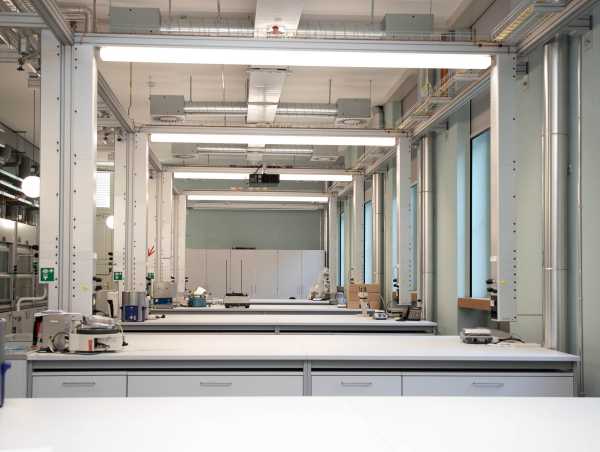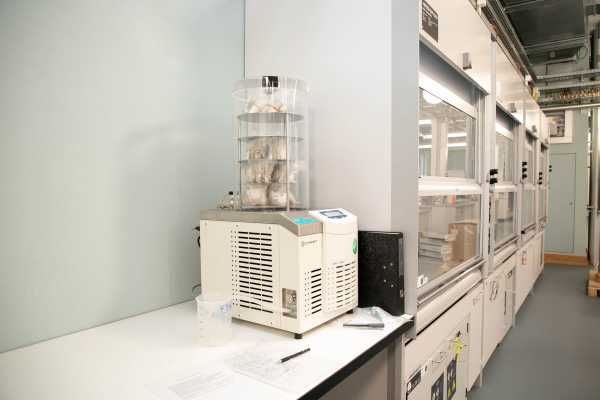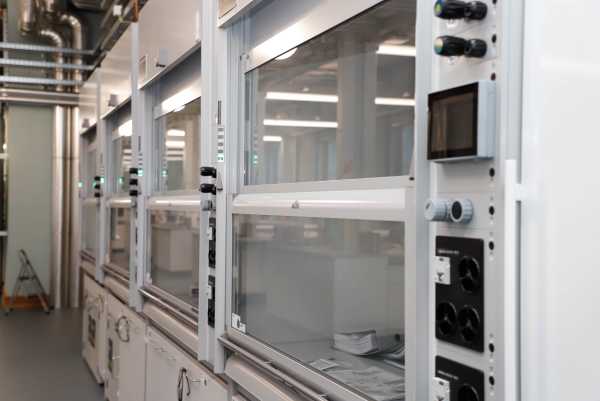Facilities
The Geological Institute has a wide range of outstandingly equipped laboratories, with a 170 m2 huge laboratory for teaching purposes.
Impressions: Teaching Lab
The Teaching Laboratory provides laboratory space to accommodate approximately 20 students in order to enable instruction on laboratory and analytical methods, and to undertake a diverse array of practical assignments.
It features several robust, widely used analytical instruments relevant to a broad array of courses in surface earth processes such as basic inorganic and organic geochemical analysis of aqueous and solid samples as well as characterization of particulate grain sizes.
- Elemental analyzer (EA)
Determination of bulk elemental composition (C, H, N, S) of rock, sediment and soil samples - Gas Chromatograph/Mass Spectrometer system (GC)M
Molecular‐level analysis of complex mixtures of organic compounds in geological matrices (sedimentary rocks, sediments, soils, petroleum). - Ion Chromatograph (IC)
The measurement of major cations and anions (Ca2+, Mg2+, K+, NH4+, Na+, HCO3‐, SO42‐, Cl‐, F‐, NO3) - Gas generator system to support instruments and preparation
Gas supplies are needed for many of the instruments (high flow N2, high purity N2, clean air, H2) and some preparation steps - UV/Vis spectrophotometer (UV/Vis)
Quantification of pigments, proteins, dissolved organic matter - Picarro CRDS for oxygen and hydrogen isotopes in waters (CRDS)
Determination of water isotopes (d2H, d18O) that is used to investigate the hydrological cycle and its links to geological processes - Mastersizer 2000 grain size analyzer
Determination of the size distribution of particles, from natural sediment/soil to materials science
The instruments in our lab allow students to directly learn the principles of basic analyses which are standard methods applied in government agencies and applied research in private consulting companies. The technology is in each case well established, comprising a mainstay of fundamental and applied research for decades, and is likely to remain relevant for the foreseeable future.
Want to work in our laboratory? Book a slot in the teaching lab.
The Rock Physics and Mechanics Laboratory (RPMLab) at ETH conducts research on the mechanical behavior and transport properties of Earth materials at conditions pertaining to the Earth’s crust and upper mantle. This is accomplished by means of experimental research coupled with microstructural studies of the micro-scale processes, and modelling of these processes. The RPMLab is working on a range of problems, including rock deformation, rock physics, elastic wave properties of rocks, volcano-tectonics, coupled thermo-hydro mechanical process in earth crust and deep reservoir characterisation.
Find out more on the Rock Physics and Mechanics Laboratory website
Laboratory head: Prof. Dr. Stefano Bernasconi
The stable Isotope Laboratory is part of the Climate geology group. One focus of our research is the development of novel analytical techniques for the analysis of the isotopes of carbon, oxygen, hydrogen, nitrogen and sulfur.
Currently we are focusing on Carbonate clumped isotopes. In particular, we are we are improving the methodologies for the analysis of clumped isotopes in carbonates in order to reduce sample sizes and are applying this method to the reconstruction of past climate change, to diagenesis and low temperature hydrothermal systems. Furthermore we work on various projects involving oxygen isotopes in phosphates, sulfates, water and carbonates, sulfur isotopes in different sulfur phases, hydrogen isotopes in water and low molecular weight hydrocarbons, and carbon and nitrogen isotopes in organic substances.
For more information have a look at the Climate Geology website.
Laboratory head: Prof. Dr. Jordon Hemingway
In addition to the Climate Geology Stable Isotope Laboratory, the Surface Earth Evolution group focuses on high-precision triple- and clumped-isotope measurements of oxygen. We build new tools and develop new methods to extract and analyze oxygen isotopes from various mineral phases (silicates, sulfates, oxides), water, and O2 gas. We specifically aim to advance these measurements in four key ways: (i) improve user safety by circumventing the need for toxic fluorine gas, (ii) increase throughput by developing automated extraction lines, (iii) improve precision and (iv) reduce necessary sample sizes by optimizing extraction line design. These analyses are useful for paleohydrology and paleoclimate reconstructions, as well as for constraining modern biogeochemical cycles.
Further information on the Surface Earth Evolution website.
Radiocarbon Prep. Laboratory
For more information about the Radiocarbon Prep. Laboratory please get in touch with Negar Haghipour.
AMS analysis is conducted at the Laboratory of Ion Beam Physics at ETH Zurich.
Low-temperature Thermochronology Laboratory
The laboratory is equipped with a range of advanced analytical instruments for fission-track and (U-Th)/He analysis. Key instruments for the separation and concentration of heavy minerals are shared with external page other laboratories and include: a jaw crusher, a vertical mill, a SelFrag machine, a Wilfley table, various magnetic separators, and an extraction hood dedicated to heavy liquid separation. Additional equipment includes mounting tools for epoxy and Teflon embedding, as well as polishing devices.
For fission-track analysis, the laboratory is equipped with two Zeiss microscopes with a maximum magnification of 2000x. These microscopes are fitted with dry and oil objectives, motorized XY(Z) stages, and cameras for precise imaging and analysis.
For the selection and measurement of minerals for (U-Th)/He analysis, the lab uses two stereoscopes, each equipped with cameras, reflected and polarized transmitted light, analyzer glass, and magnification capabilities ranging from 7.8x to 160x. Additional stereoscopes are available for packing grains in metal foil for helium extraction.
Helium extraction and measurement are carried out in the Noble Gas Lab at the Institute of Geochemistry and Petrology. The extraction is done using an infrared diode laser system equipped with a camera and pyrometer, mounted on a motorized XYZ stage. The laser is integrated with an ultra-high vacuum line, featuring getter exchange and charcoal traps, a vacuum ion pump, a turbo pump, and a fore-vacuum pump. The Helium-extraction system is connected to an in-house built sector-field mass spectrometer with a Baur-Signer ion source.
Finally, mineral digestion and preparation for Uranium and Thorium measurements are performed in a clean lab, with subsequent measurements conducted on a Thermo Fisher Scientific Element XR ICP-MS, located in the ICP-MS Lab of the Institute of Geochemistry and Petrology.
Technical support for the Low-temperature Thermochronology Laboratory is provided by Giuditta Fellin.
Cosmogenic Nuclide Sample Preparation Laboratory
The Cosmogenic Nuclide Sample Preparation Laboratory, built in 2023, consists of two adjacent labs: the Cosmogenic Mineral Separation Laboratory and the Cosmogenic Isotope Laboratory.
The Cosmogenic Mineral Separation Laboratory is dedicated to the separation of quartz from quartz-bearing rocks, followed by purification and dissolution. It features four exhaust workstations, two of which are equipped with fume washers and hotplates specially designed to treat samples with hydrofluoric acid. The laboratory also includes an oven for sample drying, vented storage cupboards, an ultrasonic tank, two ultrasonic baths, and several sample shakers for quartz cleaning and leaching.
The Cosmogenic Isotope Laboratory focuses on the chemical separation of aluminum (26Al) ,beryllium (10Be) and in-situ (14C) from quartz using the ion-exchange technique. It is also responsible for preparing samples for
accelerator mass spectrometry (AMS) target preparation and loading. This lab is equipped with two exhaust hoods, a laminar flow hood, a furnace, an analytical balance, a centrifuge, and an IonPlus target press machine.
AMS analysis is conducted at the Laboratory of Ion Beam Physics at ETH Zurich.
Technical support for the Cosmogenic Nuclide Sample Preparation Laboratory is provided by Negar Haghipour and Giuditta Fellin.



